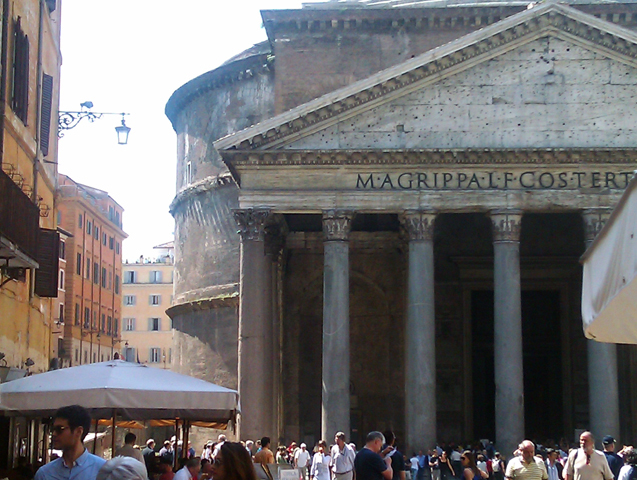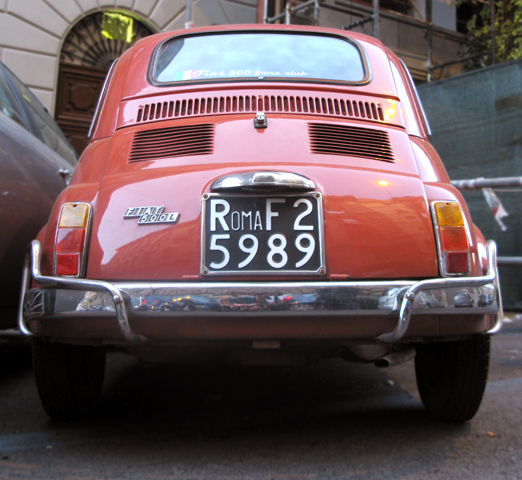 What do you get if you put 80 writers together in a courtyard garden on a sunny afternoon in Rome? No, nothing to do with typewriters or infinite monkeys. In fact, it’s The Expat Writers Book and App fair, organised by Gemelli Press and The Beehive, Rome. More than that, however, you get a plethora of conversation and meeting of like-minded people. I finally, after three years, get to meet Michelle of Bleeding Espresso in the flesh. She’s got her Gemelli Press hat on, and we’re both so busy talking to everyone that we sadly don’t get a chance to sit down and actually have a proper conversation. It will happen, just not today … Instead I talk to the many other fascinating people here. It’s not just fiction-writers, either. I meet and chat to two separate artists, as well as three authors of research papers. Then there are writers of cookery books, films, apps and much more. Three hours fly by in a haze of chat, red wine and delicious food.
What do you get if you put 80 writers together in a courtyard garden on a sunny afternoon in Rome? No, nothing to do with typewriters or infinite monkeys. In fact, it’s The Expat Writers Book and App fair, organised by Gemelli Press and The Beehive, Rome. More than that, however, you get a plethora of conversation and meeting of like-minded people. I finally, after three years, get to meet Michelle of Bleeding Espresso in the flesh. She’s got her Gemelli Press hat on, and we’re both so busy talking to everyone that we sadly don’t get a chance to sit down and actually have a proper conversation. It will happen, just not today … Instead I talk to the many other fascinating people here. It’s not just fiction-writers, either. I meet and chat to two separate artists, as well as three authors of research papers. Then there are writers of cookery books, films, apps and much more. Three hours fly by in a haze of chat, red wine and delicious food.
As the afternoon wears on into evening, the crowd thins. Conversations become less specifically about writing and more about the really important things like why there are no birds in Abruzzo, or cats vs dogs. I find myself sitting on the steps up to the hotel, chatting with Terry, Robbin and Kelly about everything and nothing in particular.
Where are we going tonight? Nobody can quite come to a decision, but Robbin, Terry and I are all non-locals at a loose end and spending the evening in isn’t an option. Linda and Steve, the owners of the Beehive, come to the rescue.
We’re going to see if this place is open. It’s cool if it is. If it isn’t we’ll find somewhere else. Happily we fall in with this plan. Kelly peels off home, bike helmet in hand, and we’re joined instead by Gillian of Gillian’s Lists and her husband, Mark. We troop off towards Termini and beyond.
Early evening in Rome is a wonderful time to wander through the streets with new friends. The stifling heat and crush of tourists from earlier in the day has gone, to be replaced by gentle warmth and people strolling in relaxed fashion. We pass a burnt-orange Fiat Cinquecento and I have to stop to take a photo for my ever-growing collection. Terry and Mark laugh at my obsession, but one day I’ll have one of my very own, even if it *will* have to be one with a sunroof so that I can actually get into it. Enticing smells waft out of every restaurant we pass. It’s still early by Roman standards – only 8.00 – so when we stop at a traditional trattoria that is apparently always stuffed to the gills with patrons, there’s a table free. The owner looks worried. We’ve got a booking for that table at 9.30. You’ll have to eat fast. We laugh at his concerns, telling him that we’re not Italian. We can do it. He grins back and ushers us in. English menus are handed out. We discard them and eye the specials menu hungrily. Decisions are made. Starters arrive and are devoured. Onto my fourth – or is it fifth? – glass of wine I witter happily with Mark about third culture kids and classic cars. Of such things are good evenings made. Suddenly, despite our assurances as we arrived, we realise that it’s 9.25 and we need to pay and go. Wallets are pulled out and 20 euro notes thrown into the centre of the table. Chairs scrape over the tiled floor as we climb lazily to our feet, discussing gelato and the various options. Linda suggests a trip to Fassi and other Rome-dwellers agree. We non-locals fall in with the plan and we all wind our way back along the now dusk-darkened Roman streets.
Fassi is a revelation. The place is enormous and brightly-lit and I don’t think I’ve ever seen so many gelato flavours in one place. It’s also absolutely heaving at just before 10pm. I really want granita, but their selection of flavours is disappointing – what, no mandorla? – so go for gelato instead. Probably no bad thing. Why eat granita in Rome, when I can get the true Sicilian version any day of the week at home?
True gelato is far creamier and thicker than ice cream, due to the magic of the production process. I don’t pretend to know very much about it further than the fact that I love eating it. However, I am told that the main difference is that gelato is churned slowly, rather than whipped, meaning that there is very little air incorporated. It’s also made with whole milk, rather than cream, and is served at a slightly higher temperature than ice-cream. Good gelato shouldn’t be neon-coloured (a good rule for food generally, in fact) and if you’ve got ice crystals in it then you’ve been had.
So back to my gelato. Whenever I try a new gelateria I go for the same two flavours, as a benchmark comparison. (What? Food is an artform here. I take it very seriously, y’know.) My favourites are stracciatella and amarena. Amarena is beautiful to look at – smooth, white vanilla with purplish-red streaks of sour cherries through it – as well as having just the right amount of sharpness from the cherries to cut through the creaminess of the gelato. Stracciatella is what would, in the UK, probably be called vanilla choc chip ice cream. That does it a major disservice, however. Not only is it the fior di latte base much less cloying than vanilla, but the chocolate isn’t in chip form. Instead, it’s drizzled over the gelato in the final stage of churning, where it first hardens and is then broken up in the churn. This means that the chocolate comes through in finer pieces, right through the gelato. A good stracciatella has a wonderful balance of creamy gelato and crunchy flecks of bitter chocolate which leaves you refreshed rather than feeling a bit sick. Sadly, this stracciatella isn’t the greatest I’ve ever had (that honour goes to the bar below my school in Calabria – yeah, I gained a fair bit of weight last summer …), but it’s streets ahead of vanilla choc-chip.
And I’m in a historic gelateria in Rome on a balmy late-spring evening, surrounded by new friends.
All in all, a pretty good end to a very good day.








Pingback: Beer and gelato » Driving Like a Maniac